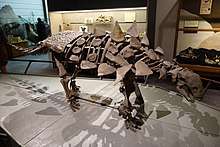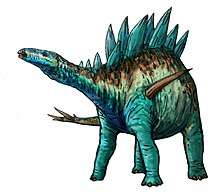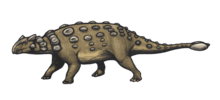Thyreophora
Thyreophora ("shield bearers", often known simply as "armored dinosaurs") is a group of armored ornithischian dinosaurs that lived from the early Jurassic Period until the end of the Cretaceous.
| Thyreophorans | |
|---|---|
 | |
| Skeletal mount of Gastonia burgei, BYU Museum of Paleontology | |
.jpg) | |
| Skeletal mount of Stegosaurus stenops, Natural History Museum, London | |
| Scientific classification | |
| Kingdom: | Animalia |
| Phylum: | Chordata |
| Clade: | Dinosauria |
| Order: | †Ornithischia |
| Clade: | †Genasauria |
| Clade: | †Thyreophora Nopcsa, 1915 |
| Subgroups | |
| |
Thyreophorans are characterized by the presence of body armor lined up in longitudinal rows along the body. Primitive forms had simple, low, keeled scutes or osteoderms, whereas more derived forms developed more elaborate structures including spikes and plates. Most thyreophorans were herbivorous and had relatively small brains for their body size.
Thyreophora includes various subgroups, including the suborders Ankylosauria and Stegosauria. In both the suborders, the forelimbs were much shorter than the hindlimbs, particularly in stegosaurs. The clade has been defined as the group consisting of all species more closely related to Ankylosaurus than to Triceratops. Thyreophora is the sister group of Cerapoda within Genasauria.
Groups of thyreophorans
Ankylosauria
Among the Ankylosauria, the two main groups are the ankylosaurids and nodosaurids.
Ankylosaurids are noted by the presence of a large tail club composed of distended vertebrae that have fused into a single mass. They were heavy-set and heavily armored from head to tail in bony armor, even down to minor features such as the eyelids. Spikes and nodules, often of horn, were set into the armor. The head was flat, stocky, with little or no "neck", roughly shovel-shaped and characterized by two spikes on either side of the head approximately where the ears and cheeks were. Euoplocephalus tutus is perhaps the best-known ankylosaurid.
Nodosaurids, the other family in the Ankylosauria, may actually include the ancestors of the ankylosaurids. They lived during the middle Jurassic (approx 170 mya) on up through the late Cretaceous (66 mya) and, while armored as the ankylosaurids, did not have a tail club. Instead, the bony bumps and spikes that covered the rest of their body continued out to the tail and/or were augmented with sharp spines. Two examples of nodosaurs are Sauropelta and Edmontonia, the latter most notable for its formidable forward-pointing shoulder spikes.
Stegosauria
The suborder Stegosauria comprises Stegosauridae and Huayangosauridae. These dinosaurs lived mostly from the Middle to Late Jurassic, although some fossils have been found in the Cretaceous. Stegosaurs had very small heads with simple, leaf-like teeth. Stegosaurs possessed rows of plates and/or spikes running down the dorsal midline and elongated dorsal vertebra. It has been suggested that stegosaur plates functioned in control of body temperature (thermoregulation) and/or were used as a display to identify members of a species, as well as to attract mates and intimidate rivals. Well known stegosaurs are Stegosaurus and Kentrosaurus.
Classification
Taxonomy
While ranked taxonomy has largely fallen out of favor among dinosaur paleontologists, a few 21st century publications have retained the use of ranks, though sources have differed on what its rank should be. Most have listed Thyreophora as an unranked taxon containing the traditional suborders Stegosauria and Ankylosauria, though Thyreophora is also sometimes classified as a suborder, with Ankylosauria and Stegosauria as infraorders.
Phylogeny
Thyreophora was first named by Nopcsa in 1915.[1] Thyreophora was defined as a clade by Paul Sereno in 1998, as "all genasaurs more closely related to Ankylosaurus than to Triceratops". Thyreophoroidea was first named by Nopcsa in 1928 and defined by Sereno in 1986, as "Scelidosaurus, Ankylosaurus, their most recent common ancestor and all of its descendants".[2] Eurypoda was first named by Sereno in 1986 and defined by him in 1998, as "Stegosaurus, Ankylosaurus, their most recent common ancestor and all of their descendants".[3] The cladogram below follows a 2011 analysis by paleontologists Richard S. Thompson, Jolyon C. Parish, Susannah C. R. Maidment and Paul M. Barrett.[4]
| Thyreophora |
| ||||||||||||||||||||||||||||||
See also
- thyreophoroi, Greek soldiers bearing a thyreos shield
References
- Nopcsa, Ferenc (1915). "Die dinosaurier der Siebenbürgischen landesteile Ungarns" (PDF). Mitteilungen aus dem Jahrbuche der Kgl. 23: 1–24.
- Sereno, Paul (1986). "Phylogeny of the bird-hipped dinosaurs (order Ornithischia)". National Geographic Research. 2 (2): 234–256.
- Paul, Sereno (1998). "A rationale for phylogenetic definitions, with application to the higher-level taxonomy of Dinosauria". Neues Jahrbuch für Geologie und Paläontologie, Abhandlungen. 210 (1): 41–83.
- Richard S. Thompson, Jolyon C. Parish, Susannah C. R. Maidment and Paul M. Barrett (2011). "Phylogeny of the ankylosaurian dinosaurs (Ornithischia: Thyreophora)". Journal of Systematic Palaeontology. 10 (2): 301–312. doi:10.1080/14772019.2011.569091.CS1 maint: multiple names: authors list (link)


